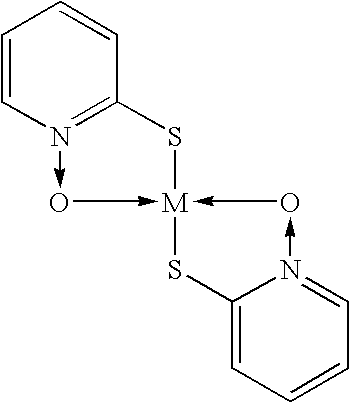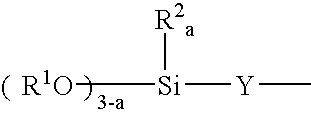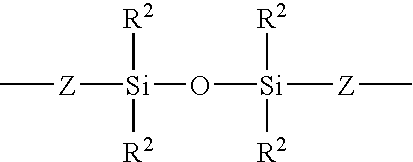Inhibition/Reduction in Discoloration of Diorganopolysiloxane Compositions
a technology of diorganopolysiloxane and composition, applied in the field of inhibiting or reducing can solve the problems of yellowing of composition, increasing intensity of yellowing, and products obtained from such compositions will also change their appearance, so as to reduce the discoloration of diorganopolysiloxane composition, the effect of eliminating disadvantages
- Summary
- Abstract
- Description
- Claims
- Application Information
AI Technical Summary
Benefits of technology
Problems solved by technology
Method used
Image
Examples
example 1
Practical Example 1
[0070] 65 parts by weight of α, ω-di(triethoxysilylethylene)dimethylpolysiloxane having viscosity of 60,000 mPa·s (represented by formula 1 below) and 35 parts by weight of α, ω-dimethyldimethylpolysilox having viscosity of 100 mPa·s (represented by formula 2 below) were combined with 100 parts by weight of precipitated calcium carbonate that contained 0.16 wt. % of iron oxide and which was surface treated with fatty acids to a BET specific surface area of 18 m2 / g, 25 parts by weight of ground calcium carbonate that contained 0.19 wt. % of iron oxide surface treated with fatty acids to a BET specific surface area of 5.8, a cross-linking agent in the form of 2.8 parts by weight of methyltrimethoxysilane and 2.8 parts by weight of isobutyltrimethoxysilane, 2.5 parts by weight of curing catalyst in the form of a titanium-di(isopropoxy)bis-(ethylacetoacetate), and 1.0 part by weight of an adhesion promoter in the form of a reaction mixture of (γ-aminopropyl-trimethoxy...
example 2
Practical Example 2
[0073] A room-temperature-curable silicone rubber composition was prepared by the same method as in Practical Example 1, with the exception that mixed composition was combined and uniformly mixed with 0.02 parts by weight of the mixture composed of 10 parts by weight of(2-pyridylthio-1-oxide) zinc salt (Zinc Pyrithion) and 90 parts by weight of a polydimethylsiloxane having molecular terminals capped with trimethylsiloxy groups and having a 3,000 mPa·s viscosity. The content of the obtained room-temperature-curable silicone rubber composition is shown in Table 1. The obtained room-temperature-curable silicone rubber composition was held for 7 days and for 18 weeks under the same conditions as in Practical Example 1, and then the face and back surfaces of the cured sheet were used for measuring color characteristics and color difference. The results of measurements are shown in Tables 2 and 3.
example 3
Practical Example 3
[0074] A room-temperature-curable silicone rubber composition was prepared by the same method as in Practical Example 1, with the exception that mixed composition was combined and uniformly mixed with 0.05 parts by weight of the mixture composed of 10 parts by weight of (2-pyridylthio-1-oxide) zinc salt (Zinc Pyrithion) and 90 parts by weight of a polydimethylsiloxane having molecular terminals capped with trimethylsiloxy groups and having a 3,000 mPa·s viscosity. The content of the obtained room-temperature-curable silicone rubber composition is shown in Table 1. The obtained room-temperature-curable silicone rubber composition was held for 7 days and for 18 weeks under the same conditions as in Practical Example 1, and then the face and back surfaces of the cured sheet were used for measuring color characteristics and color difference. The results of measurements are shown in Tables 2 and 3.
PUM
| Property | Measurement | Unit |
|---|---|---|
| wt. % | aaaaa | aaaaa |
| viscosity | aaaaa | aaaaa |
| viscosity | aaaaa | aaaaa |
Abstract
Description
Claims
Application Information
 Login to View More
Login to View More - R&D
- Intellectual Property
- Life Sciences
- Materials
- Tech Scout
- Unparalleled Data Quality
- Higher Quality Content
- 60% Fewer Hallucinations
Browse by: Latest US Patents, China's latest patents, Technical Efficacy Thesaurus, Application Domain, Technology Topic, Popular Technical Reports.
© 2025 PatSnap. All rights reserved.Legal|Privacy policy|Modern Slavery Act Transparency Statement|Sitemap|About US| Contact US: help@patsnap.com



